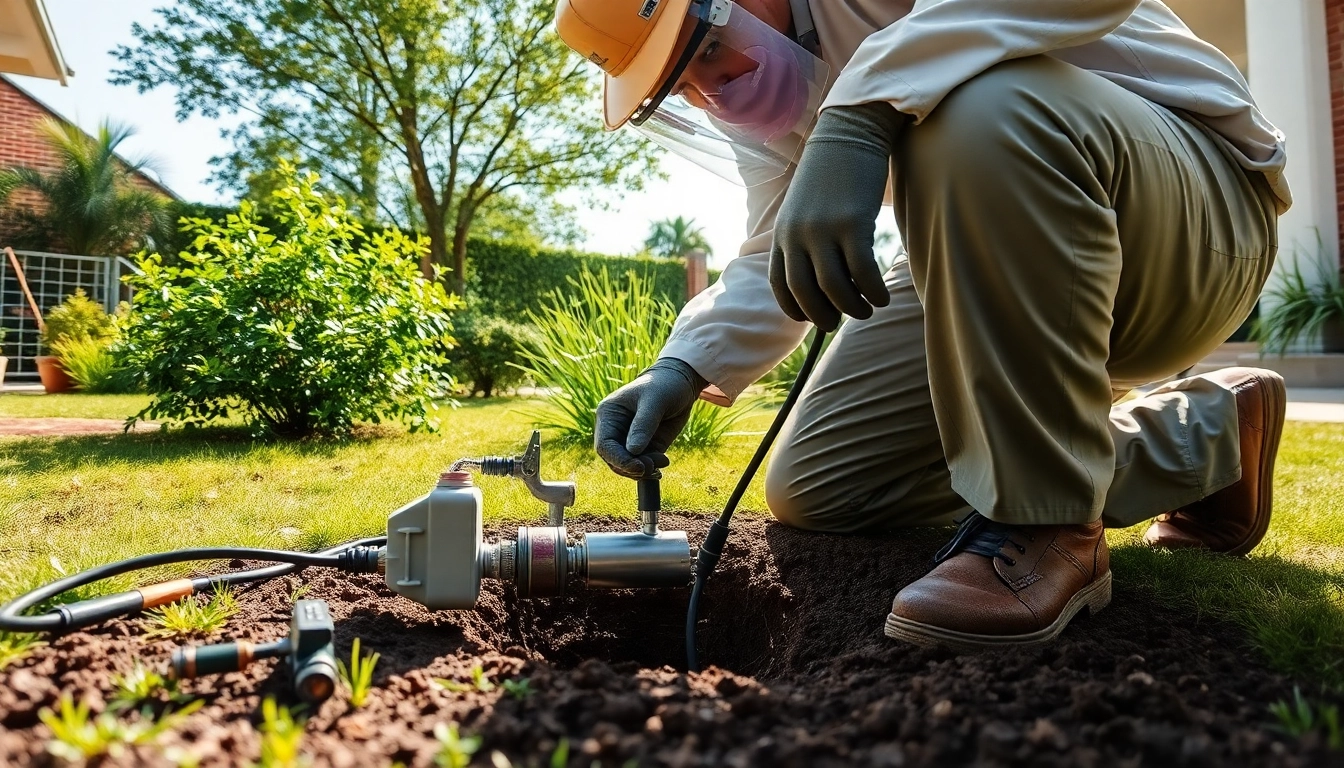What is a Termite Reticulation System?
Definition and Purpose
A termite reticulation system is an advanced pest management solution aimed at protecting homes and buildings from the destructive nature of termites. This system consists of a network of underground pipes installed around the perimeter of a property, which allows for the targeted delivery of chemical treatments specifically designed to kill and repel termites. The ease of access provided by this system enables homeowners to maintain their property’s structural integrity by reducing the risk of termite infestations that can lead to severe damage.
Components of the System
The integral components of a termite reticulation system include the following:
- Pipes: These are typically made of durable materials such as polyethylene or PVC, laid out strategically around the foundation of a home to ensure comprehensive coverage.
- Access Points: Custom-designed points on the surface level allow for easy access to the pipe network for refills and maintenance.
- Chemical Reservoirs: These reservoirs house the termite treatment chemicals that flow through the pipes and into the soil.
- Application Equipment: Specialized equipment is employed by technicians to attach to the access points for the refilling process.
How It Works for Termite Control
Once installed, the system continuously dispenses a measured amount of insecticide into the soil surrounding the home. The chemicals seep into the ground, creating a barrier that either kills any termites that come into contact with it or deters them from approaching the property. The effectiveness of this method lays in its capacity to deliver a sustained treatment over an extended period, generally resulting in lower termite activity and a reduced need for extensive repairs.
Importance of Regular Termite Reticulation System Refills
Why Refills are Necessary
The primary reason for regular termite reticulation system refills is to ensure the continued effectiveness of the treatment. Chemicals lose their potency over time, influenced by environmental factors such as rainfall, temperature fluctuations, and soil conditions. Most systems require refills every 3 to 5 years, depending on the type of chemical used and the geographical location. Performing regular refills not only maintains an effective barrier against termites, but also helps prevent future infestations that could lead to extensive damage and costly repairs.
Consequences of Neglecting Refills
Failing to adhere to the recommended refill schedule can lead to significant consequences. As the chemical barrier diminishes, termites can penetrate the soil undeterred, creating colonies within the structures of your home. This not only ruins the aesthetic value of your property but can also lead to structural failures. The cost of repairing termite damage can often run into the thousands, outweighing the expense and effort associated with regular refills.
Protecting Your Home and Investment
Your home is likely one of your most significant investments, and protecting it goes beyond regular maintenance. A properly functioning termite reticulation system is a vital aspect of home protection. By investing in regular refills and maintenance, homeowners can maintain their property’s structural integrity and the overall safety of their environment.
How to Know When It’s Time for a Refill
Signs Your System Needs Attention
Observing signs that indicate the need for a refill is crucial. Some common indicators include:
- Lack of assessed termiticide presence in the soil during routine inspections.
- Increased sightings of termites or termite damage in and around your home.
- Active signs of termite activity, such as mud tubes or wood damage.
Industry Guidelines for Refill Frequency
While the standard refill frequency typically ranges from 3 to 5 years, some advanced systems might require refills every 6 to 8 years, depending on the active ingredients used. It’s essential to follow the manufacturer’s recommendations and consult with pest control professionals for tailored advice based on environmental conditions.
Seasonal Considerations
Seasonal changes can have significant effects on termite activity and the effectiveness of reticulation systems. For instance, during warmer months, termites are more active and might require more frequent monitoring and refills to counteract any potential infestation threats. In colder months, however, termite activity typically decreases, leading to a lower urgency for immediate refills.
The Process of Refilling a Termite Reticulation System
Step-by-Step Refilling Process
The refilling process involves several steps that ensure the reticulation system operates optimally:
- Inspection: A professional pest control technician will assess the system to ensure all components are functioning and check for signs of termite activity.
- Access: The technician will locate and access the system’s designated refill points using the appropriate tools.
- Preparation: Necessary precautions are taken to ensure safety during the refill process, including wearing protective gear and ensuring the integrity of surrounding soil is maintained.
- Refilling: Using specialized equipment, the technician will inject the new chemical solution into the pipes, ensuring proper distribution throughout the system.
- Testing: Following the refill, the system will be tested to confirm proper function and coverage, mitigating any risks of leaks or inefficiencies.
Choosing the Right Chemicals for Refills
When considering options for refills, selecting the appropriate chemicals plays a crucial role in the effectiveness of treatment. Some popular active ingredients include:
- Fipronil: Known for its effectiveness, Fipronil disrupts termites’ nervous systems and is commonly used in various termite control products.
- Imidacloprid: This chemical is a neonicotinoid that prevents termites from feeding, which leads to their eventual die-off.
- Boric Acid: Considered a more eco-friendly option, boric acid is lethal to termites upon ingestion and can work effectively in reticulation systems.
Professional vs. DIY Refilling
When considering refills, homeowners may wonder if a DIY approach is feasible. While some basic maintenance can be done independently, such as visual inspections, the refilling process itself is best left to professionals. Pest control technicians have the necessary training, equipment, and experience to handle chemicals safely and effectively, ensuring your reticulation system continues to perform optimally. Furthermore, professionals can adequately analyze any potential termite threats during refills, which a homeowner may overlook.
Cost Considerations for Termite Reticulation System Refills
Average Prices and Influencing Factors
The cost of refilling a termite reticulation system can vary significantly based on several factors:
- Geographical Location: Costs can fluctuate depending on regional pricing factors for labor and chemical supply.
- Type of Chemical Used: Advanced or specialized treatments may come at a higher price point compared to standard options.
- System Complexity: The size and design of the established system will invariably influence the refill cost.
On average, homeowners can expect to spend between $150 to $500 for a complete refill, depending on these factors.
Cost-Benefit Analysis of Regular Refills
When evaluating the costs associated with refills, it’s essential to weigh these expenses against potential benefits. Regular refills can drastically reduce the likelihood of significant termite damage, which can amount to thousands of dollars in repair costs if neglected. Additionally, maintaining a robust pest management strategy can enhance the value of your property, making it more attractive to future buyers.
Potential Savings with Preventative Maintenance
Investing in preventative measures, such as consistent refills, not only protects your investment but can also offer long-term savings. Homeowners who commit to maintaining their termite reticulation systems often find that the upfront costs of refills are far less than the potential expenditure required for extensive repairs due to undetected termite infestations. Being proactive helps ensure lower overall maintenance costs in the long run.



